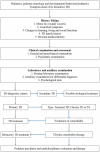Exploring acupuncture as a therapeutic approach for tic disorders: a review of current understanding and potential benefits
- PMID: 40162008
- PMCID: PMC11949814
- DOI: 10.3389/fneur.2025.1447818
Exploring acupuncture as a therapeutic approach for tic disorders: a review of current understanding and potential benefits
Abstract
Tic disorders (TD) refer to a condition where individuals experience recurring motor movements (e.g., eye blinking) and/or vocalizations (e.g., throat clearing). These disorders vary in terms of duration, cause, and manifestation of symptoms. Tourette's syndrome (TS) involves the presence of ongoing motor and vocal tics for a minimum of 1 year, with fluctuating intensity. Persistent chronic motor or vocal tic disorder is characterized by either motor or vocal tics (not both) present for at least 1 year. Provisional TD presents with either motor or vocal tics (not both) that have been present for less than 12 months. Though medications like Aripiprazole and dopamine receptor blockers are frequently prescribed, their potential unwanted consequences increase, may result in low adherence. In an effort to improve and broaden the care available for children diagnosed with TD, alternative methods such as acupuncture are being investigated and considered. Acupuncture is a method of traditional Chinese medicine that includes the placement of thin needles into particular areas of the body in order to correct any disruptions or irregularities. Research has demonstrated that acupuncture can help regulate abnormal brain function and relieve tic symptoms in individuals with TD. Additional studies are required to fully evaluate the usefulness of complementary treatments in addressing TD in young individuals, despite its common usage. Herein, we summarized the therapeutic effects of acupuncture in the treatment of TD.
Keywords: acupuncture; bio-active compound; natural compound; therapy; tic disorders.
Copyright © 2025 Liu, Wang, Zhang and Rezaei.
Conflict of interest statement
The authors declare that the research was conducted in the absence of any commercial or financial relationships that could be construed as a potential conflict of interest.
Figures
Similar articles
-
Acupuncture and other traditional Chinese medicine therapies in the treatment of children's tic syndrome: A network meta-analysis.Front Neurosci. 2023 Apr 17;17:1156308. doi: 10.3389/fnins.2023.1156308. eCollection 2023. Front Neurosci. 2023. PMID: 37144087 Free PMC article.
-
Evidence-based treatment of Tourette's disorder and chronic tic disorders.Expert Rev Neurother. 2019 Nov;19(11):1103-1115. doi: 10.1080/14737175.2019.1643236. Epub 2019 Jul 17. Expert Rev Neurother. 2019. PMID: 31295410 Review.
-
An Empirical Examination of Symptom Substitution Associated With Behavior Therapy for Tourette's Disorder.Behav Ther. 2016 Jan;47(1):29-41. doi: 10.1016/j.beth.2015.09.001. Epub 2015 Sep 11. Behav Ther. 2016. PMID: 26763495 Free PMC article. Clinical Trial.
-
Current Status, Diagnosis, and Treatment Recommendation for Tic Disorders in China.Front Psychiatry. 2020 Aug 13;11:774. doi: 10.3389/fpsyt.2020.00774. eCollection 2020. Front Psychiatry. 2020. PMID: 32903695 Free PMC article. Review.
-
A Single Case of Tourette's Syndrome Treated with Traditional Chinese Medicine.J Acupunct Meridian Stud. 2017 Jan;10(1):55-61. doi: 10.1016/j.jams.2016.12.005. Epub 2016 Dec 18. J Acupunct Meridian Stud. 2017. PMID: 28254105
References
-
- First MB. DSM-5-TR® handbook of differential diagnosis. NY, USA: American Psychiatric Pub; (2013).
Publication types
LinkOut - more resources
Full Text Sources



